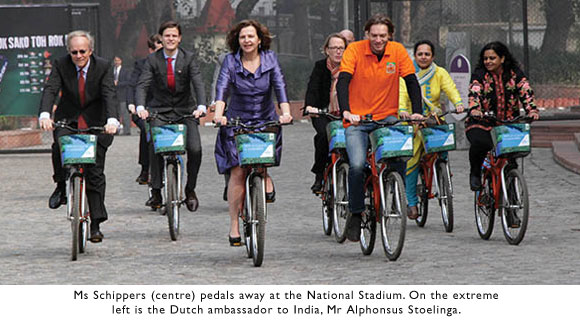The Dutch Minister for Health, Welfare and Sport, Ms. Edith Schippers, visited India between January 29 and 31, 2014 to strengthen Indo-Dutch collaboration in the areas of sports, life sciences and health. She was accompanied by a delegation of Dutch public and private organizations in the field of sports infrastructure development, as well as a delegation of scientists from Erasmus Medical Centre Rotterdam.
Sports Infrastructure
On January 31, 2014, India and Netherlands signed an MoU on cooperation in the field of sports. The MoU was signed by Minister of State for Youth Affairs and Sports (Independent Charge) Jitendra Singh, and Ms Schippers. The MoU provides for exchange of knowledge and experience in the fields of Sports Management, competition infrastructure set-up, coaching, training systems, training of referees for various sports disciplines and top-sport development through youth academies.
The MoU also provides for cooperation and exchange programmes in the field of innovative sports infrastructure development and management including financial development, spatial area development, planning of sports infrastructure and facilities, designing of sports infrastructure and facilities, exploitation of resources, management training and safety & security. In the MoU, two areas, that is feasibility study or Detailed Project Report on the area development and resource exploitation possibilities around one major stadium in Delhi, and feasibility study on the development and management of turnkey indoor sporting units to increase broad access to sporting facilities nationwide. It will also explore the possibility of opening a pilot unit that is included for immediate execution.
Science and Technology
On January 30, 2014, Ms. Schippers and the Indian Minister for Science and Technology, Mr. Jaipal Reddy launched a large-scale, long-term study on thousands of people to determine causes of stroke and cognitive decline. The Indian Department of Biotechnology (Ministry of Science and Technology) has committed over EUR 4 million to the project. Stroke mortality in India is 25 times that of malaria. Earlier research has shown that Indians may be more susceptible to stroke than their western counterparts. An Indian younger than 65 years is more likely to suffer a stroke than his European counterpart, data on the oldest old is lacking.
Erasmus MC and the All India Institute of Medical Sciences (AIIMS) will jointly investigate this intriguing finding. Beginning in 2015, a group of 15 000 people aged 50 and above will be followed for 10 years to assess risk factors associated with stroke and Alzheimer’s disease. The findings will be compared with those of similar studies being carried out by Erasmus MC such as 'The Rotterdam study'.
“With this study, we will get a clearer picture on which factors increase the chance of stroke. Does it have to do with genetic factors? Or are factors such as diet, hygiene and smoking or tobacco chewing more important? Answers to these questions will give us leads on how to prevent stroke and related disorders,” says Professor Gabriel P. Krestin, head of the Radiology Department of Erasmus MC.
This visit of the Dutch Health Minister is a follow-up of her previous visit to India in May 2012, when she led a trade mission of companies and organizations in the field of life sciences & health and sports.

Cycling
Also on January 30, 2014, Ms Schippers took a cycling tour around the Major Dhyan Chand National Stadium where the Netherlands won the first edition of the Hero Hockey World League Final in the third week of January. The Minister promoted the Netherlands as a nation of bicycles and showcased cycling as a healthy and nature friendly mode of transport.
“The Dutch love to cycle. It’s fun, healthy exercise, and nature-friendly. I am very happy to see that also in Delhi there are more and more cycling lanes. There is even a Dutch company that organizes cycling tours to explore Old Delhi.”
Cycling became popular in the Netherlands in the 1880s, and by the 1890s the Dutch were already building dedicated paths for cyclists. By 1911, the Dutch owned more bicycles per capita than any other country in Europe.
The popularity of cycling as it is now started in the 1970s when Dutch people took to the streets to protest against the high number of child deaths on the roads: in some cases over 500 children were killed in car accidents in the Netherlands in a single year. This protest came to be known as the "Stop the Child Murder"-movement. The success of this movement—along with other factors, such as the oil shortages of 1973-74—turned Dutch government policy around. The country began to restrict motor vehicles in its towns and cities and direct its focus on growth towards other forms of transport, with the bicycle being seen as critical in making Dutch streets safer, and its towns and cities more people-friendly and livable.
|